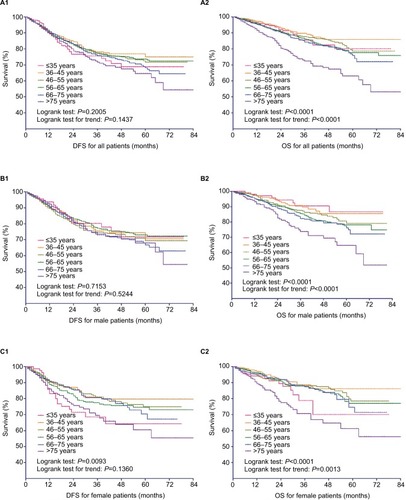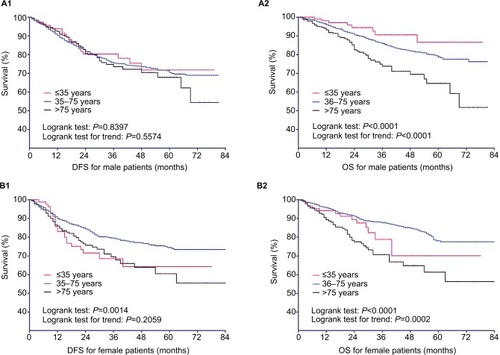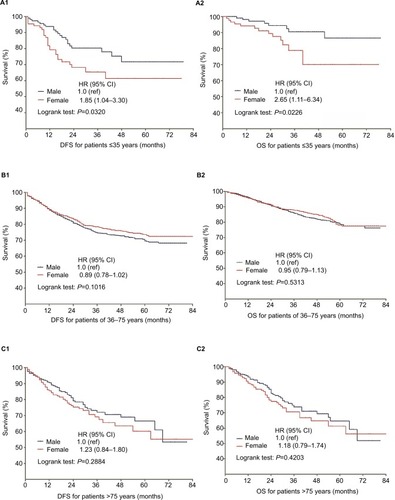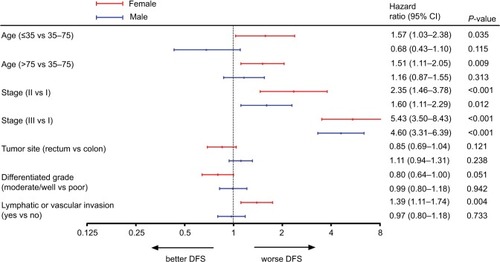Abstract
Purpose
To investigate the association of age and sex on survival in non-metastatic colorectal cancer (CRC) patients and to identify groups at high risk for poor outcomes.
Materials and methods
We performed a retrospective analysis of 5,047 non-metastatic CRC patients from 2008 to 2013. Data regarding age at diagnosis; gender; tumor site; tumor stage; differentiation; lymphatic, neural or vascular invasion; and survival outcomes were collected. Patients were stratified into 10-year age groups (≤35, 36–45, 46–55, 56–65, 66–75, >75) and then further analyzed in three age groups (≤35, 36–75, >75). Disease-free survival (DFS) and overall survival (OS) were evaluated using univariate and multivariate Cox regression models.
Results
Of the 5,047 eligible patients, 41.3% were female. The tumor stages were balanced between the genders. In the female patients, the tumor stages were similarly distributed among the different age groups, while younger male patients were diagnosed with more advanced disease (P<0.001 for trend). When stratified into three age groups, young females experienced significantly poorer survival than young males (DFS: hazard ratio [HR]=1.85 [1.04–3.30], OS: HR=2.65 [1.11–6.34]). After adjusting for tumor stage, site, differentiated grade and lymphatic or vascular invasion status, females ≤35 and >75 had shorter DFS than patients between 36 and 75 years old (HR=1.57 [1.03–2.38] and HR=1.51 [1.11–2.05, respectively]), while there was no difference in DFS between females ≤35 and those >75. For male patients, older age was associated with poorer OS after the same adjustment.
Conclusion
Young female CRC patients (≤35 years old) had the poorest DFS and quite poor OS compared to the other age groups. This emphasizes the need for health care providers to have a heightened awareness and to conduct further research when caring for young female CRC patients.
Introduction
Colorectal cancer (CRC) is the third most commonly diagnosed cancer globally, with 1.36 million new cases in 2012 that resulted in more than 690,000 deaths.Citation1 In China, CRC is the fourth most common cancer, with a crude incidence rate of 26.9/100,000, and it represents 9.4% of new cancer cases as well as 7.38% of cancer deaths despite advances in screening, early diagnosis and treatment.Citation2
Age and gender are important clinical factors related to patient outcomes for CRC. In most countries, incidence and mortality rates are considerably higher in men than in women.Citation1 The impact of age and gender on the prognostic outcome of CRC patients remains controversial and varies in different regions. Many studies have shown that CRC in the younger population is correlated with later tumor stage and poorer prognosis,Citation3,Citation4 whereas other studies have reported contradictory results.Citation5,Citation6
Age has a particularly significant impact on female CRC patients due to hormonal changes, hormone replacement therapy and their association with CRC. In studies focused on the impact of age, 45 or 50 years old is often chosen as the delineating benchmark between pre- and post-menopause. It has been reported that young, premenopausal women have better outcomes than young men, while older women experience similar or poorer outcomes than older men, although the reasons underlying these observations are unknown.Citation7,Citation8 Fu et alCitation9 reported that young CRC patients (≤35 years old) have poorer outcomes due to the diagnosis of more advanced stage disease, based on a sample of 2,460 Chinese patients.
Therefore, the purpose of this retrospective study was to compare long-term outcomes between male and female non-metastatic CRC patients of all age groups.
Materials and methods
Data collection
This was a hospital-based retrospective epidemiological study of CRC cases admitted to Fudan University Shanghai Cancer Center (FUSCC) between January 2008 and July 2013. Patients with pathologically confirmed colorectal cancer who underwent surgical treatment were included. Exclusion factors included the presence of in situ carcinoma, distant metastasis or recurrent cancer. In total, 5,047 patients were included in the analysis. Clinicopathological information including age at diagnosis, gender, tumor site, pathological TNM stage, tumor differentiation, lymphatic or vascular invasion, and neural invasion was gathered from the patient charts, and disease-free survival (DFS) and overall survival (OS) were calculated through follow-up. The pathological stage of each case was re-classified according to the AJCC (American Joint Committee on Cancer) 7th edition TNM staging system.
After surgery, patient follow-up was scheduled every 3 months during the first 2 years and then every 6 months over the following 3 years. After 5 years, the frequency of follow-up was extended to once each year. The follow-up data were collected by reviewing medical records or by telephone or mail correspondence. The deadline for follow-up was October 2017. This study was approved by the Institutional Review Board of Fudan University Shanghai Cancer Center (IRB1403132-2) and all patients had signed written informed consent prior to the study.
Statistical analysis
All characteristics were described by frequencies and percentages for categorical variables, by means and standard deviations for normally distributed continuous data, and by medians and interquartile ranges for non-normally distributed continuous data. The characteristics were analyzed by the Student t-test, the Mann–Whitney U test, and the chi-square (χ2) test.
DFS was defined as the time between primary treatment of surgery and first occurrence of recurrence, metastasis of CRC, or death due to any cause. Patients without any of these events during the follow-up were censored at their last followup. OS was calculated from primary treatment of surgery to death due to any cause. Patients who were still alive at the end of follow-up were censored at their last follow-up. Survival curves were estimated using the Kaplan–Meier method and compared with the log-rank test. Cox proportional hazards regression was used for univariate and multivariate modeling to examine the prognostic significance of the variables identified in the models. P-values of less than 0.05 indicated statistically significant differences. All analyses were performed with SAS 9.2 software.
Results
Patient characteristics
The distributions of the demographic, clinical and pathological features of the 5,047 eligible non-metastatic CRC cases are listed in . In total, 58.7% of patients were male, with a median age of 60, while 41.3% were female, with a median age of 58. The median follow-up time was 38 months in both groups. More rectal tumors, lymphatic or vascular invasion and neural invasion were observed in male patients, while the tumor stages and differentiated grades were similar between genders. The 3-year DFS and OS were 75.7% and 85.2%, while the 5-year DFS and OS were 70.4% and 77.1%, respectively, for all patients.
Table 1 Clinicopathological characteristics of 5,047 non-metastatic colorectal cancer patients
In , the stage distributions are shown in different age groups. Overall, in the male population, younger patients were diagnosed at more advanced stages (both P<0.001), but the same was not true in female patients.
Table 2 Distribution of stages in different age groups between male and female patients
Impact of age and gender on survival outcomes
As shown in , no statistically significant differences were observed in DFS; however, the oldest group (>75) had the poorest OS out of all the groups. There was no significant difference in DFS between different age groups in men. However, the OS of the older population was shorter than that of the other age groups, which could be explained by the presence of other comorbidities and worsening health in older people. Female patients in the middle age groups did not show any significant differences in DFS and OS. However, the youngest female group (<35) had shorter DFS and OS than those of the middle age groups (35–75). Further analyses of the survival curves of the three age groups for both genders are given in .
Figure 1 Kaplan–Meier curves of DFS and OS in all patients and separate gender groups stratified by six consecutive age groups.
Note: DFS for all patients (A1), male patients (A2) and female patients (A3); OS for all patients (A2), male patients (B2) and female patients (C2).
Abbreviations: DFS, disease-free survival; OS, overall survival.

Figure 2 Kaplan–Meier curves of DFS and OS in male and female patients stratified by three different age groups.
Notes: DFS (A1) and OS (A2) for male patients; DFS (B1) and OS (B2) for female patients.
Abbreviations: DFS, disease-free survival; OS, overall survival.

When stratified by the three different age groups, young female CRC patients (≤ 35 years old) had significantly shorter survival times than young male patients (DFS: hazard ratio [HR]=1.85 [1.04–3.30], OS: HR=2.65 [1.11–6.34]), while there was no significant difference in survival between genders in the other two age groups ().
Figure 3 Kaplan–Meier curves of DFS and OS in three different age groups stratified by gender.
Notes: DFS in patients ≤35 (A1), 36–75 (B1) and >75 (C1) years old; DFS in patients ≤35 (A2), 36–75 (B2) and >75 years old (C2).
Abbreviations: DFS, disease-free survival; OS, overall survival; ref, reference.

Univariate and multivariate analyses for DFS and OS
Because of different long-term prognosis patterns, univariate and multivariate analyses for DFS and OS were conducted in male and female CRC patients (, , ). In male patients, advanced tumor TNM stage was significantly associated with both decreased DFS and OS, and age >75 years old was significantly associated with decreased OS only in the univariate analysis. In female patients, advanced tumor stage, age ≤35 or >75 years old, tumor site, poor differentiation, lymphatic or vascular invasion and neural invasion were significantly associated with decreased DFS and OS.
Figure 4 Forest plot for DFS based on multivariate COX model analyses of prognostic factors for both male and female colorectal cancer patients.
Abbreviation: DFS, disease-free survival.

In the multivariate analyses of male patients, advanced tumor stage was a prognostic factor for both poor DFS (stage II vs I, HR=1.60 [1.11–2.29]; stage III vs I, HR=5.43 [3.50–8.43]) and OS (stage II vs I, HR=1.97 [1.19–3.26]; stage III vs I, HR=5.57 [3.79–8.89]). In addition, older age was significant associated with poor OS (≤35 vs 36–75, HR=0.38 [0.17–0.86]; >75 vs 36–75, HR=2.17 [1.61–2.93]).
Female patients ≤35 and >75 had poorer DFS than patients between 36 and 75 years old (HR=1.57 [1.03–2.38], HR=1.51 [1.11–2.05, respectively]) according to multivariate analyses, while there was no significant difference in DFS between females >75 and ≤35 years old. Advanced tumor stage (stage II vs I, HR=2.35 [1.46–3.78]; stage III vs I, HR=5.43 [3.50–8.43]) and lymphatic or vascular invasion (HR=1.39 [1.11–1.74]) were significant prognostic factors for shorter DFS. Female patients >75 years old, advanced tumor stage and poorer differentiated grade were associated with shorter OS.
Discussion
There is a plethora of opinions about the effects of age and gender on the outcomes of colorectal cancer in previously published studies,Citation3,Citation5,Citation8 especially when defining the benchmark age between young and old patients. However, previous studies mainly focused on one aspect, either age or gender. To the best of our knowledge, this is the largest Chinese study from a single tertiary specialist center comparing non-metastatic CRC patients by age and gender.
Recent research has focused on colorectal cancer in young adults. Changing life behaviors including unhealthy diets, sedentary lifestyles and poor environmental conditions have been proposed as factors contributing to higher incidences of CRC in younger populations. Some studies have reported that young CRC patients often have more aggressive tumor characteristics and poorer survival,Citation3,Citation4,Citation9 but this remains controversial.Citation6,Citation10,Citation11 One possible reason for more aggressive tumors and poorer survival in younger CRC patients is that routine CRC screening omits the young population, leading to CRC that cannot be prevented by removing premalignant polyps.Citation12 Moreover, Chou et al have shown that the incidence of poorly mucinous and signet-ring cell carcinoma is higher in young CRC patients.Citation4 The molecular biology of CRCs in young patients appears to be different, and younger patients tend to have higher rates of microsatellite instability (MSI-H).Citation13
We found that age plays a different role in CRC depending on gender. Young female CRC patients had poorer DFS than older groups, and young female CRC patients had poorer OS than young male CRC patients. In our population, young female patients (≤35 years old) had more advanced stage tumors than other age groups, with more than half of the patients in stage III. This might explain the relatively poor outcomes in young female CRC patients. In our study, both male and female CRC patients older than 75 years old had the poorest OS. This may be partially due to other complications in the geriatric population.
The role of sex hormones in colorectal cancer formation and differentiation is unclear. Given the diverse range of opinions and results with respect to estrogen and estrogen-progesterone therapy, our results show a need to reexamine the role of sex hormones in CRC and to determine whether a higher level of estrogen or progesterone is beneficial or detrimental to the patient. Among postmenopausal women, endogenous estrogens may confer protection against colorectal tumorigenesis.Citation14 However, the cancers were diagnosed at a more advanced stage, and there was no suggestion of reduced colorectal cancer mortality in the group receiving estrogen plus progestin combined hormone therapy.Citation15 However, a more recent study showed that estrogen therapy significantly reduced the risk of CRC.Citation16 Another study also showed that cancers in the combined hormone therapy group more commonly had positive lymph nodes and were at higher stages. Although not statistically significant, there was a higher number of colorectal cancer deaths in the combined hormone therapy group.Citation17 Young females usually have relatively high levels of sex hormones, which may be another reason we found young female CRC patients (≤35 years old) had worse DFS in our study, although this requires further validation.
CRC during pregnancy is uncommon but deserves attention. Bernstein et al found that the mean age at presentation was 31 years old in 41 cases of women who presented with CRC during pregnancy or in the immediate postpartum period.Citation18 The diagnosis and staging of CRC are challenging issues during pregnancy owing to the overlap of symptoms.Citation19 The signs and the symptoms of CRC such as abdominal pain, anorectal bleeding and constipation may be attributed to pregnancy. In a prospective study, maternal serum levels of CA 125, CEA and CA 19-9 could be increased during the third trimester of pregnancy; however, these elevations were within the normal range.Citation20 There are many limitations and contraindications when using diagnostic tools and treatment during pregnancy, depending on the legal, ethical, personal, religious or emotional concepts.Citation21–Citation23 Taken together, these factors lead to late diagnosis, advanced tumor stages and poor patient outcomes.Citation23–Citation25 Usually, females <35 years old have a higher possibility to get pregnant and give birth than females >35 years old. However, data on pregnancy were unavailable for our study.
We acknowledge the limitations inherent in our study, which was performed in a single institution with a relatively short follow-up time. Young CRC patients (≤35 years old) only compose a small portion of the whole population (3.9% of male patients and 4.2% of female patients). Due to the retrospective nature of this study, we only performed a stratified analysis based on different age groups and genders. Data on reproductive histories, hormonally related factors, surgical procedures, adjuvant chemotherapy or radiotherapy and patient comorbidities were missing in the analysis. Moreover, specific pathological data including histology and genetic status such as mutations in RAS, BRAF and MMR were also missing in this study.
The results of this study stress the need for early routine screenings to improve the prevention of CRC in China. Compared to the USA, which has 40% of CRC cases diagnosed in early stages, outcomes in China could be drastically improved by raising awareness of the need for regular check-ups. In view of our findings and data from previous studies, further validation in other databases is also necessary. Meanwhile, prospective studies are required to determine whether gender-related factors or hormones are of prognostic relevance in non-metastatic CRC patients. Further studies should be conducted to explore the effect of sex hormones and pregnancy in female CRC patients to better treat this population.
Conclusion
Female colorectal cancer patients younger than 35 have poor survival outcomes, especially when compared to young male patients (<35 years old) and older female patients (36–75 years old). These findings emphasize the need for health care providers to have a heightened awareness when caring for young female CRC patients.
Acknowledgments
This study was partially supported by grants from the Shanghai Science Foundation (13ZR1408100) and the Imaging Foundation of Fudan University Shanghai Cancer Center (YX201601).
The abstract was accepted as a poster in the 2016 ASCO meeting.
Supplementary materials
Table S1 Univariate analyses of prognostic factors for DFS and OS based on Cox proportional hazard model between male and female CRC patients
Table S2 Multivariate analyses of prognostic factors for DFS and OS based on Cox proportional hazard model between male and female CRC patients
Disclosure
The authors report no conflicts of interest in this work.
References
- FerlayJSoerjomataramIDikshitRCancer incidence and mortality worldwide: sources, methods and major patterns in GLOBOCAN 2012Int J Cancer2015136E35938625220842
- ChenWZhengRZhangSCancer incidence and mortality in China in 2013: an analysis based on urbanization levelChin J Cancer Res20172911028373748
- O’ConnellJBMaggardMALivingstonEHYoCKColorectal cancer in the youngAm J Surg200418734334815006562
- ChouCLChangSCLinTCDifferences in clinicopathological characteristics of colorectal cancer between younger and elderly patients: an analysis of 322 patients from a single institutionAm J Surg201120257458221872205
- YeoSAChewMHKohPKTangCLYoung colorectal carcinoma patients do not have a poorer prognosis: a comparative review of 2,426 casesTech Coloproctol20131765366123460362
- LiQCaiGLiDWangYZhuoCCaiSBetter long-term survival in young patients with non-metastatic colorectal cancer after surgery, an analysis of 69,835 patients in SEER databasePLoS One20149e9375624699879
- HendifarAYangDLenzFGender disparities in metastatic colorectal cancer survivalClin Cancer Res2009156391639719789331
- KooJHJalaludinBWongSKKneeboneAConnorSJLeongRWImproved survival in young women with colorectal cancerAm J Gastroenterol20081031488149518510616
- FuJYangJTanYYoung patients (≤ 35 years old) with colorectal cancer have worse outcomes due to more advanced disease: a 30-year retrospective reviewMedicine (Baltimore)201493e13525415667
- SchellererVSMerkelSSchumannSCDespite aggressive histopathology survival is not impaired in young patients with colorectal cancer: CRC in patients under 50 years of ageInt J Colorectal Dis201227717921881876
- O’ConnellJBMaggardMALiuJHEtzioniDAKoCYAre survival rates different for young and older patients with rectal cancer?Dis Colon Rectum2004472064206915657655
- AhnenDJWadeSWJonesWFThe increasing incidence of young-onset colorectal cancer: a call to actionMayo Clin Proc20148921622424393412
- GryfeRKimHHsiehETTumor microsatellite instability and clinical outcome in young patients with colorectal cancerN Engl J Med2000342697710631274
- MurphyNStricklerHDStanczykFZA prospective evaluation of endogenous sex hormone levels and colorectal cancer risk in postmenopausal womenJ Natl Cancer Inst2015107djv210
- RitenbaughCStanfordJLWuLConjugated equine estrogens and colorectal cancer incidence and survival: the Women’s Health Initiative randomized clinical trialCancer Epidemiol Biomarkers Prev2008172609261818829444
- LinKJCheungWYLaiJYGiovannucciELThe effect of estrogen vs. combined estrogen-progestogen therapy on the risk of colorectal cancerInt J Cancer201213041943021365647
- SimonMSChlebowskiRTWactawski-WendeJEstrogen plus progestin and colorectal cancer incidence and mortalityJ Clin Oncol2012303983399023008295
- BernsteinMAMadoffRDCaushajPFColon and rectal cancer in pregnancyDis Colon Rectum1993361721788425421
- MoricePUzanCUzanSCancer in pregnancy: a challenging conflict of interestLancet201237949549622325648
- ErcanŞKaymazÖYücelNOrçunASerum concentrations of CA 125, CA 15-3, CA 19-9 and CEA in normal pregnancy: a longitudinal studyArch Gynecol Obstet201228557958421792548
- PeccatoriFAAzimHAJrOrecchiaRCancer, pregnancy and fertility: ESMO Clinical Practice Guidelines for diagnosis, treatment and follow-upAnn Oncol201324Suppl 6vi160170
- BaysingerCLImaging during pregnancyAnesth Analg201011086386720185662
- BukhariYHoganNMPomeroyMO’LearyMJoyceMRSurgical management of rectal cancer in pregnancyInt J Colorectal Dis20132888388422821142
- DoganNUTastekinDKerimogluOSPekinACelikCRectal cancer in pregnancy: a case report and review of the literatureJ Gastrointest Cancer20134435435623196388
- PigeauHDuprePFBenounaJ[Management of rectal cancer in pregnant women] Cancer du rectum et grossesse: quelle conduite à tenirBull Cancer200592953958 French16316829
